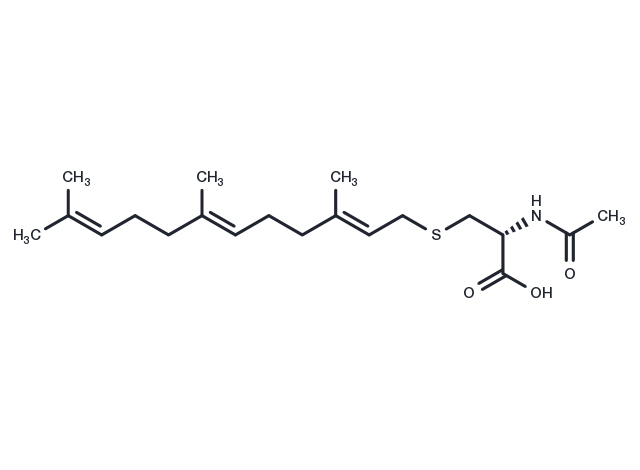Powder: -20°C for 3 years | In solvent: -80°C for 1 year


Arazine (N-Acetyl-S-farnesyl-L-cysteine) can be a a substrate for isoprenylcysteine methyltransferase by competing with prenylated G protein or its receptors site. Arazine is a cell-permeable modulator of G protein and GPCR signaling.

| Pack Size | Availability | Price/USD | Quantity |
|---|---|---|---|
| 1 mg | In stock | $ 106.00 | |
| 25 mg | 6-8 weeks | Inquiry | |
| 50 mg | 6-8 weeks | Inquiry |

| Description | Arazine (N-Acetyl-S-farnesyl-L-cysteine) can be a a substrate for isoprenylcysteine methyltransferase by competing with prenylated G protein or its receptors site. Arazine is a cell-permeable modulator of G protein and GPCR signaling. |
| In vitro | Arazine (10–100 μM; 8h) significantly affects the HMEC-1 cell viability as measured by trypan blue exclusion in HMEC-1 cell. Arazine (2h) inhibits ATPγS induced CXCL1, CXCL8 and CCL2 production as a dose-dependent manner in HMEC-1 cell[2]. |
| In vivo | Arazine (2,000 μg/20 μl) produces a dose-dependent inhibition of the TPA-induced edema, with the maximal reduction of edema approaching 73%, with an ED50 of 55 μg/20 μl[2]. |
| Synonyms | N-Acetyl-S-farnesyl-L-cysteine |
| Molecular Weight | 367.55 |
| Formula | C20H33NO3S |
| CAS No. | 135304-07-3 |
Powder: -20°C for 3 years | In solvent: -80°C for 1 year
You can also refer to dose conversion for different animals. More
bottom
Please see Inhibitor Handling Instructions for more frequently ask questions. Topics include: how to prepare stock solutions, how to store products, and cautions on cell-based assays & animal experiments, etc.
Arazine 135304-07-3 Others inhibit cell-permeable substrate N-Acetyl-S-farnesyl-L-cysteine Inhibitor modulator inhibitor
